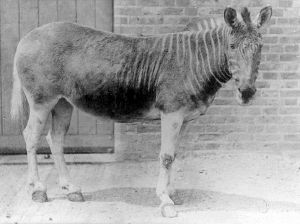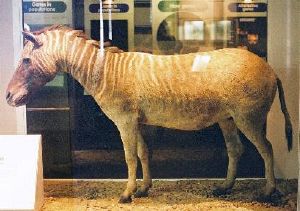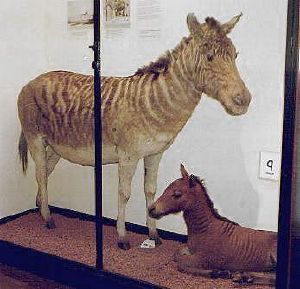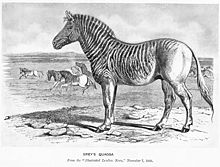Difference between revisions of "Quagga" - New World Encyclopedia
Rick Swarts (talk | contribs) (added article from Wikipedia and credit/category tags) |
Rick Swarts (talk | contribs) |
||
| Line 24: | Line 24: | ||
The '''quagga''' ('''''Equus quagga quagga''''') is an [[List of extinct animals|extinct]] subspecies of the [[Plains zebra]],<ref>[http://www.petermaas.nl/extinct/speciesinfo/quagga.htm "Equus quagga quagga"]. ''The Extinction Website''. Reference May 19, 2008.</ref> which was once found in great numbers in [[South Africa]]'s [[Cape Province]] and the southern part of the [[Orange Free State]]. It was distinguished from other zebras by having the usual vivid marks on the front part of the body only. In the mid-section, the stripes faded and the dark, inter-stripe spaces became wider, and the rear parts were a plain brown. The name comes from a [[Khoikhoi]] word for ''zebra'' and is [[Onomatopoeia|onomatopoeic]], being said to resemble the quagga's call. The only quagga to have ever been photographed alive was a mare at the Zoological Society of London's Zoo in Regent's Park in 1870. | The '''quagga''' ('''''Equus quagga quagga''''') is an [[List of extinct animals|extinct]] subspecies of the [[Plains zebra]],<ref>[http://www.petermaas.nl/extinct/speciesinfo/quagga.htm "Equus quagga quagga"]. ''The Extinction Website''. Reference May 19, 2008.</ref> which was once found in great numbers in [[South Africa]]'s [[Cape Province]] and the southern part of the [[Orange Free State]]. It was distinguished from other zebras by having the usual vivid marks on the front part of the body only. In the mid-section, the stripes faded and the dark, inter-stripe spaces became wider, and the rear parts were a plain brown. The name comes from a [[Khoikhoi]] word for ''zebra'' and is [[Onomatopoeia|onomatopoeic]], being said to resemble the quagga's call. The only quagga to have ever been photographed alive was a mare at the Zoological Society of London's Zoo in Regent's Park in 1870. | ||
| + | |||
| + | :'''Grévy's zebra''' is the common name for the largest species of [[zebra]], '''''Equus grevyi''''', characterized by large, rounded ears, erect and striped mane, and a short coat with narrow and close-set black and white stripes that extend to the hooves. Also known as the '''Imperial zebra''', it is the largest wild member of the [[horse]] family [[Equidae]]. This [[odd-toed ungulate]] is found in Ethiopia and Kenya. | ||
| + | |||
| + | ==Overview and description== | ||
| + | '''Zebra''' is the common name for various wild, [[horse]]-like [[ungulate#Perissodactyla: Odd-toed ungulates|odd-toed ungulates]] (Order Perissodactyla) of the family [[Equidae]] and the [[genus]] ''Equus,'' native to eastern and southern [[Africa]] and characterized by distinctive white and black (or brown) stripes that come in different patterns unique to each individual. | ||
| + | |||
| + | Grévy's zebra ''(Equus grevyi)'' is a member of the [[Equidae]], a family of [[odd-toed ungulate]] [[mammal]]s of [[horse]]s and horse-like animals. There are three basic groups recognized in Equidae—horses, asses, and zebras—although all extant equids are in the same genus of ''Equus''. | ||
| + | |||
| + | Grévy's zebra is one of three or four extant species of [[zebra]]s. The other extant species are the [[plains zebra]] ''(E. quagga)'', the [[Mountain zebra|Cape mountain zebra]] ''(Equus zebra)'' and the Hartmann's mountain zebra ''(E. hartmannae)'', which are placed together in the subgenus ''Hippotigris''. The Cape mountain zebra and Hartmann's mountain zebra are sometimes treated as the same species. Grévy's zebra ''(E. grevyi)'' is placed in its own subgenus of ''Dolichohippus.'' In many respects, it is more akin to the [[ass]]es (subgenus ''Asinus''), while the other zebras are more closely related to the horses (subgenus ''Equus''). Nevertheless, DNA and molecular data show that zebras do indeed have [[monophyletic]] origins. In certain regions of [[Kenya]], the plains zebras and Grevy's zebras coexist. | ||
==Range & Habitat== | ==Range & Habitat== | ||
Revision as of 16:12, 8 February 2009
Template:Alternateuses
- Not to be confused with quokka.
| Quagga | ||||||||||||||||||
|---|---|---|---|---|---|---|---|---|---|---|---|---|---|---|---|---|---|---|
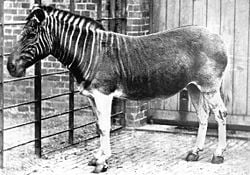 Quagga in London Zoo, 1870
| ||||||||||||||||||
| Scientific classification | ||||||||||||||||||
| ||||||||||||||||||
| †Equus quagga quagga Boddaert, 1785 |
The quagga (Equus quagga quagga) is an extinct subspecies of the Plains zebra,[2] which was once found in great numbers in South Africa's Cape Province and the southern part of the Orange Free State. It was distinguished from other zebras by having the usual vivid marks on the front part of the body only. In the mid-section, the stripes faded and the dark, inter-stripe spaces became wider, and the rear parts were a plain brown. The name comes from a Khoikhoi word for zebra and is onomatopoeic, being said to resemble the quagga's call. The only quagga to have ever been photographed alive was a mare at the Zoological Society of London's Zoo in Regent's Park in 1870.
- Grévy's zebra is the common name for the largest species of zebra, Equus grevyi, characterized by large, rounded ears, erect and striped mane, and a short coat with narrow and close-set black and white stripes that extend to the hooves. Also known as the Imperial zebra, it is the largest wild member of the horse family Equidae. This odd-toed ungulate is found in Ethiopia and Kenya.
Overview and description
Zebra is the common name for various wild, horse-like odd-toed ungulates (Order Perissodactyla) of the family Equidae and the genus Equus, native to eastern and southern Africa and characterized by distinctive white and black (or brown) stripes that come in different patterns unique to each individual.
Grévy's zebra (Equus grevyi) is a member of the Equidae, a family of odd-toed ungulate mammals of horses and horse-like animals. There are three basic groups recognized in Equidae—horses, asses, and zebras—although all extant equids are in the same genus of Equus.
Grévy's zebra is one of three or four extant species of zebras. The other extant species are the plains zebra (E. quagga), the Cape mountain zebra (Equus zebra) and the Hartmann's mountain zebra (E. hartmannae), which are placed together in the subgenus Hippotigris. The Cape mountain zebra and Hartmann's mountain zebra are sometimes treated as the same species. Grévy's zebra (E. grevyi) is placed in its own subgenus of Dolichohippus. In many respects, it is more akin to the asses (subgenus Asinus), while the other zebras are more closely related to the horses (subgenus Equus). Nevertheless, DNA and molecular data show that zebras do indeed have monophyletic origins. In certain regions of Kenya, the plains zebras and Grevy's zebras coexist.
Range & Habitat
The Quagga lived in the drier parts of South Africa, on grassy plains. The northern limit seems to have been the Orange River in the west and the Vaal River in the east; the south-eastern border may have been the Great Kei River.
Taxonomy
The quagga was originally classified as an individual species, Equus quagga, in 1778. Over the next fifty years or so, many other zebras were described by naturalists and explorers. Because of the great variation in coat patterns (no two zebras are alike), taxonomists were left with a great number of described "species", and no easy way to tell which of these were true species, which were subspecies, and which were simply natural variants.
Long before this confusion was sorted out, the quagga had been hunted to extinction for meat, hides, and to preserve feed for domesticated stock. The last wild quagga was probably shot in the late 1870s, and the last specimen in captivity, a mare, died on August 12, 1883 at the Artis Magistra zoo in Amsterdam. Because of the great confusion between different zebra species, particularly among the general public, the quagga had become extinct before it was realized that it appeared to be a separate species.
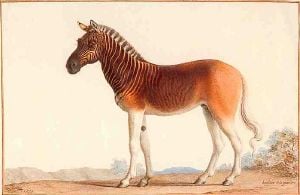
The quagga was the first extinct creature to have its DNA studied. Recent genetic research at the Smithsonian Institution has demonstrated that the quagga was in fact not a separate species at all, but diverged from the extremely variable plains zebra, Equus burchelli, between 120,000 and 290,000 years ago, and suggests that it should be named Equus burchelli quagga. However, according to the rules of biological nomenclature, where there are two or more alternative names for a single species, the name first used takes priority. As the quagga was described about thirty years earlier than the plains zebra, it appears that the correct terms are E. quagga quagga for the quagga and E. quagga burchelli for the plains zebra, unless "Equus burchelli" is officially declared to be a nomen conservandum.
After the very close relationship between the quagga and surviving zebras was discovered, the Quagga Project was started by Reinhold Rau in South Africa to recreate the quagga by selective breeding from plains zebra stock, with the eventual aim of reintroducing them to the wild. This type of breeding is also called breeding back. In early 2006, it was reported that the third and fourth generations of the project have produced animals which look very much like the depictions and preserved specimens of the quagga, though whether looks alone are enough to declare that this project has produced a true "re-creation" of the original quagga is controversial. DNA from mounted specimens was successfully extracted in 1984, but the technology to use recovered DNA for breeding does not yet exist. In addition to skins such as the one held by the Natural History Museum in London, there are 23 known stuffed and mounted quagga throughout the world. A twenty-fourth specimen was destroyed in Königsberg, Germany (now Kaliningrad), during World War II.[3]
Quagga hybrids and similar animals
Zebras have been cross-bred to other equines such as donkeys and horses. There are modern animal farms which continue to do so. The offspring are known as zeedonks, zonkeys and zorses (the term for all such zebra hybrids is zebroid). Zebroids are often exhibited as curiosities although some are broken to harness or as riding animals. On January 20, 2005, Henry, a foal of the Quagga Project, was born. He most resembles the quagga.
There is a record of a quagga bred to a horse in the 1896 work Anomalies and Curiosities of Medicine by George M. Gould and Walter L. Pyle:
- In the year 1815 Lord Morton put a male quagga to a young chestnut mare of seven-eighths Arabian blood, which had never before been bred from. The result was a female hybrid which resembled both parents.[4]
In his 1859 The Origin of Species, Charles Darwin recalls seeing coloured drawings of zebra-donkey hybrids, and mentions "Lord Moreton's famous hybrid from a chesnut [sic] mare and male quagga..." Darwin mentioned this particular hybrid again in 1868 in The Variation Of Animals And Plants Under Domestication,[5] and provides a citation to the journal in which Lord Morton first described the breeding.
Okapi markings are nearly the reverse of the quagga, with the forequarters being mostly plain and the hindquarters being heavily striped. However, the okapi is no relation of the quagga, horse, donkey, or zebra. Its closest taxonomic relative is the giraffe.
In popular culture
A quagga appears in a sequence in the Soviet Union's animated The Cat Who Walked by Herself, in which Dog tracks the hoofprints of one, and Cat tells the boy of the Red Book of endangered species, and how Quagga had "her track severed" (that is, made extinct) due to Man's selfish actions.
A Quagga is one of the main characters in The Katurran Odyssey, a fantasy children's book by David Michael Wieger.
And the Quagga has had a part in the book Artemis Fowl: The Time Paradox, by author Eoin Colfer, where the protagonist, Artemis Fowl, is made to ride a Quagga in his attempts to flee the clutches of an evil pixie genius, Opal Koboi.
The Quagga can be unlocked in the computer game Zoo Tycoon 2 This is the only unlockable that is a real extinct animal. The quagga can be earned through fossil hunting before unlocking it. It is also able to be unlocked in freeform (after you have managed to release all the extinct animals), which is rare for rewards in the game. It is able to interbreed with the common zebra. Once unlocked, it will become available at Challenge and Campaign games at 1.5 stars in Zoo Tycoon 2
The Quagga is also seen in the book Skybreaker by Kenneth Oppel when a stuffed specimen was found on the abandonded airship Hyperion.
The Quagga is mentioned in Jurassic Park as one of the animals that could be recreated by INGEN or Biosyn using DNA extracted from the hides of the Quagga.
See also
- List of extinct animals
ReferencesISBN links support NWE through referral fees
- ↑ Hack, M.A., East, R. & Rubenstein, D.I. (2008). Equus quagga quagga. In: IUCN 2008. IUCN Red List of Threatened Species. Downloaded on 5 January 2008.
- ↑ "Equus quagga quagga". The Extinction Website. Reference May 19, 2008.
- ↑ Max D.T. 2006. Can You Revive an Extinct Animal? The New York Times. Published: January 1 2006.
- ↑ Hartwell, S. Hybrid Mammals. Downloaded at July 24 2006 at http://www.messybeast.com/genetics/hybrid-mammals.html.
- ↑ Darwin, C. 1883. The Variation of Animals and Plants Under Domestication. Second Edition, Revised. D. Appleton & Co, New York. Online available at http://www.esp.org/books/darwin/variation/facsimile/title3.html.
Other sources
- , M.A., East, R. & Rubenstein, D.I. 2002. Equus quagga. In: 2006 IUCN Red List of Threatened Species. Last accessed on 8 March 2007
External links
- ARKive - images and movies of the quagga (Equus quagga)
- The Quagga Project
- PBS Nature: Restoring the Quagga
- Biology Letters: A rapid loss of stripes: the evolutionary history of the extinct quagga, 2005
- The Extinction Website - Species Info - Quagga
- African Explorer - Bringing the Quagga back to life.
- "Quagga Quest Can we bring back a long-extinct animal?"
| |||||||||||||||||||||||||||||||||||||
| |||||||||||
Credits
New World Encyclopedia writers and editors rewrote and completed the Wikipedia article in accordance with New World Encyclopedia standards. This article abides by terms of the Creative Commons CC-by-sa 3.0 License (CC-by-sa), which may be used and disseminated with proper attribution. Credit is due under the terms of this license that can reference both the New World Encyclopedia contributors and the selfless volunteer contributors of the Wikimedia Foundation. To cite this article click here for a list of acceptable citing formats.The history of earlier contributions by wikipedians is accessible to researchers here:
The history of this article since it was imported to New World Encyclopedia:
Note: Some restrictions may apply to use of individual images which are separately licensed.

